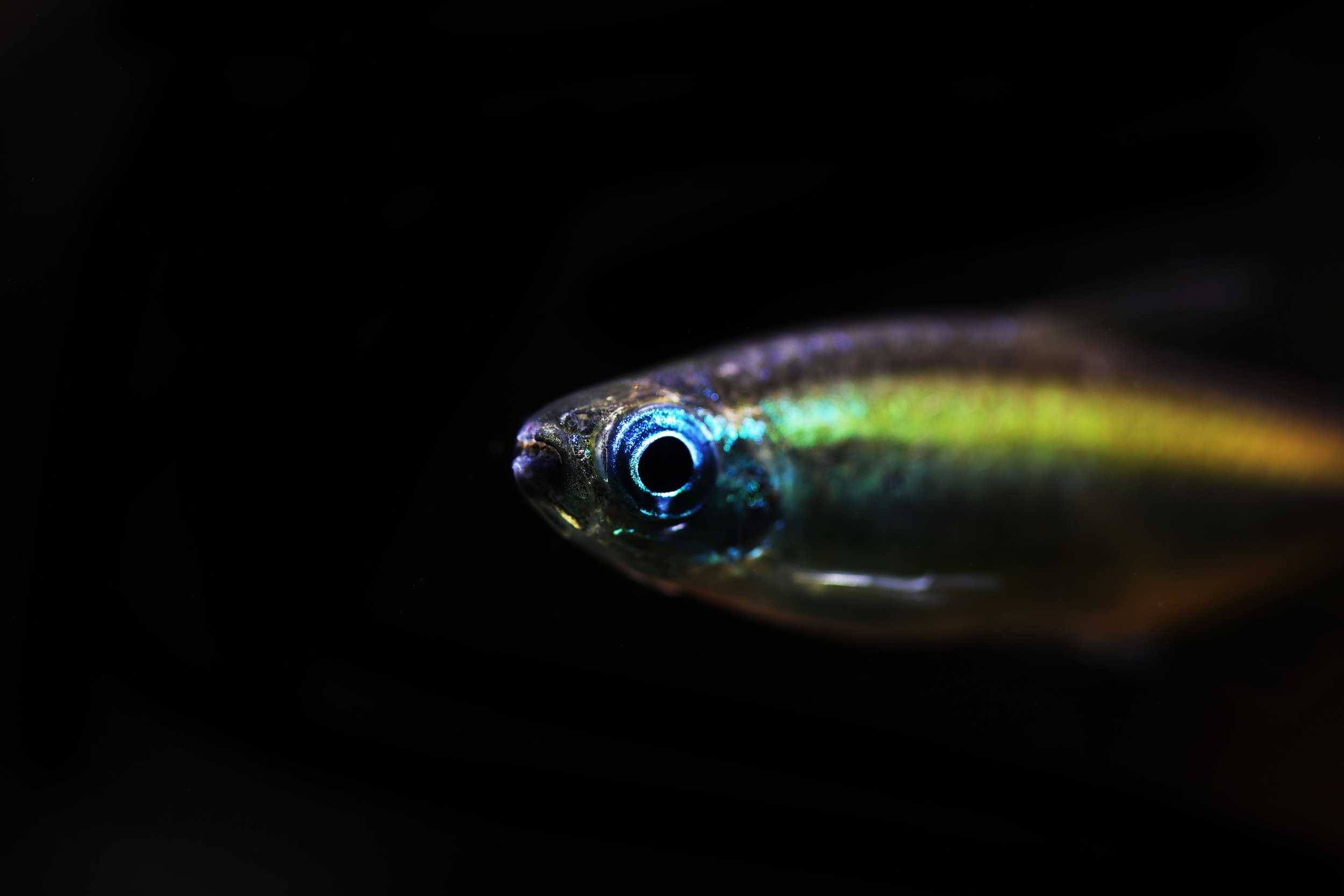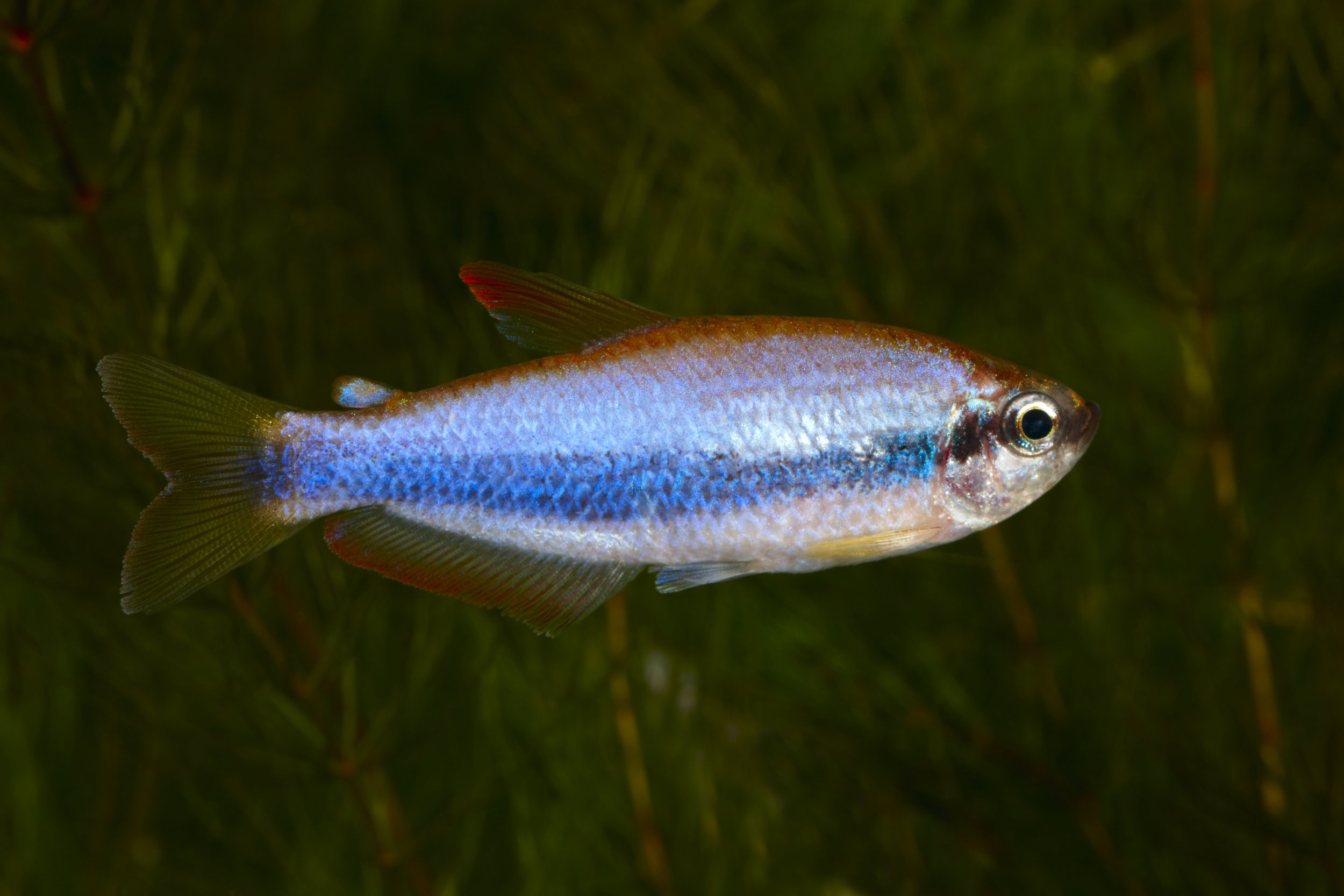 Image 1 of
Image 1 of


Bleeding Heart Tetra
The Bleeding Heart Tetra, scientifically known as Hyphessobrycon erythrostigma, is a captivating and popular freshwater fish species admired by aquarists for its striking appearance and peaceful demeanor. Native to the slow-moving rivers and streams of the Amazon Basin in South America, this tetra is a beautiful addition to community aquariums, adding a touch of elegance and vibrant color.
Physically, the Bleeding Heart Tetra is known for its distinctive and eye-catching coloration. The body is typically a silvery-pink or translucent hue, with a prominent red spot located in the center of its body, just behind the gills. This red spot resembles a drop of blood, giving the fish its common name. The fins of the Bleeding Heart Tetra are often tinged with red or pink, and the dorsal fin, in particular, is elongated and can display a dark edging, adding to the fish's overall appeal. Mature specimens typically reach lengths of around 2 to 3 inches (5 to 7.5 centimeters), making them well-suited for medium to large-sized aquariums.
In aquariums, Bleeding Heart Tetras thrive in well-planted tanks with plenty of hiding spots and open swimming areas. They appreciate a setup that includes a dark substrate and subdued lighting, which helps enhance their colors and create a naturalistic environment. These tetras are peaceful and do well in community tanks with other non-aggressive species. It’s recommended to keep them in groups of at least six individuals, as they are schooling fish and feel most secure when surrounded by others of their kind.
Water parameters for Bleeding Heart Tetras should closely mimic those of their native habitat. They prefer slightly acidic to neutral water with a pH range of 6.0 to 7.5 and temperatures between 72 to 80°F (22 to 27°C). Maintaining stable water conditions with regular water changes and good filtration is crucial for their health and well-being.
Feeding Bleeding Heart Tetras is straightforward, as they are omnivorous and will accept a variety of foods. They readily consume high-quality flakes, pellets, and granules, as well as live or frozen foods such as bloodworms, brine shrimp, and daphnia. Providing a varied diet ensures they receive all the necessary nutrients for optimal health and vibrant coloration.
Breeding Bleeding Heart Tetras in captivity is possible with the right conditions and setup. To encourage breeding, provide a separate breeding tank with soft, slightly acidic water and fine-leaved plants or spawning mops for egg deposition. After spawning, the parents should be removed to prevent them from eating the eggs. The eggs typically hatch within 24 to 36 hours, and the fry can be raised on infusoria or other microscopic foods until they are large enough to consume baby brine shrimp or finely powdered fry food.
Overall, the Bleeding Heart Tetra (*Hyphessobrycon erythrostigma*) is a stunning and valuable addition to freshwater aquariums, prized for its unique coloration, peaceful nature, and ease of care. With proper attention to their specific requirements, these beautiful tetras can thrive and bring a touch of elegance and color to aquarists of all levels of experience, enhancing the beauty and tranquility of any aquatic environment.
The Bleeding Heart Tetra, scientifically known as Hyphessobrycon erythrostigma, is a captivating and popular freshwater fish species admired by aquarists for its striking appearance and peaceful demeanor. Native to the slow-moving rivers and streams of the Amazon Basin in South America, this tetra is a beautiful addition to community aquariums, adding a touch of elegance and vibrant color.
Physically, the Bleeding Heart Tetra is known for its distinctive and eye-catching coloration. The body is typically a silvery-pink or translucent hue, with a prominent red spot located in the center of its body, just behind the gills. This red spot resembles a drop of blood, giving the fish its common name. The fins of the Bleeding Heart Tetra are often tinged with red or pink, and the dorsal fin, in particular, is elongated and can display a dark edging, adding to the fish's overall appeal. Mature specimens typically reach lengths of around 2 to 3 inches (5 to 7.5 centimeters), making them well-suited for medium to large-sized aquariums.
In aquariums, Bleeding Heart Tetras thrive in well-planted tanks with plenty of hiding spots and open swimming areas. They appreciate a setup that includes a dark substrate and subdued lighting, which helps enhance their colors and create a naturalistic environment. These tetras are peaceful and do well in community tanks with other non-aggressive species. It’s recommended to keep them in groups of at least six individuals, as they are schooling fish and feel most secure when surrounded by others of their kind.
Water parameters for Bleeding Heart Tetras should closely mimic those of their native habitat. They prefer slightly acidic to neutral water with a pH range of 6.0 to 7.5 and temperatures between 72 to 80°F (22 to 27°C). Maintaining stable water conditions with regular water changes and good filtration is crucial for their health and well-being.
Feeding Bleeding Heart Tetras is straightforward, as they are omnivorous and will accept a variety of foods. They readily consume high-quality flakes, pellets, and granules, as well as live or frozen foods such as bloodworms, brine shrimp, and daphnia. Providing a varied diet ensures they receive all the necessary nutrients for optimal health and vibrant coloration.
Breeding Bleeding Heart Tetras in captivity is possible with the right conditions and setup. To encourage breeding, provide a separate breeding tank with soft, slightly acidic water and fine-leaved plants or spawning mops for egg deposition. After spawning, the parents should be removed to prevent them from eating the eggs. The eggs typically hatch within 24 to 36 hours, and the fry can be raised on infusoria or other microscopic foods until they are large enough to consume baby brine shrimp or finely powdered fry food.
Overall, the Bleeding Heart Tetra (*Hyphessobrycon erythrostigma*) is a stunning and valuable addition to freshwater aquariums, prized for its unique coloration, peaceful nature, and ease of care. With proper attention to their specific requirements, these beautiful tetras can thrive and bring a touch of elegance and color to aquarists of all levels of experience, enhancing the beauty and tranquility of any aquatic environment.
The Bleeding Heart Tetra, scientifically known as Hyphessobrycon erythrostigma, is a captivating and popular freshwater fish species admired by aquarists for its striking appearance and peaceful demeanor. Native to the slow-moving rivers and streams of the Amazon Basin in South America, this tetra is a beautiful addition to community aquariums, adding a touch of elegance and vibrant color.
Physically, the Bleeding Heart Tetra is known for its distinctive and eye-catching coloration. The body is typically a silvery-pink or translucent hue, with a prominent red spot located in the center of its body, just behind the gills. This red spot resembles a drop of blood, giving the fish its common name. The fins of the Bleeding Heart Tetra are often tinged with red or pink, and the dorsal fin, in particular, is elongated and can display a dark edging, adding to the fish's overall appeal. Mature specimens typically reach lengths of around 2 to 3 inches (5 to 7.5 centimeters), making them well-suited for medium to large-sized aquariums.
In aquariums, Bleeding Heart Tetras thrive in well-planted tanks with plenty of hiding spots and open swimming areas. They appreciate a setup that includes a dark substrate and subdued lighting, which helps enhance their colors and create a naturalistic environment. These tetras are peaceful and do well in community tanks with other non-aggressive species. It’s recommended to keep them in groups of at least six individuals, as they are schooling fish and feel most secure when surrounded by others of their kind.
Water parameters for Bleeding Heart Tetras should closely mimic those of their native habitat. They prefer slightly acidic to neutral water with a pH range of 6.0 to 7.5 and temperatures between 72 to 80°F (22 to 27°C). Maintaining stable water conditions with regular water changes and good filtration is crucial for their health and well-being.
Feeding Bleeding Heart Tetras is straightforward, as they are omnivorous and will accept a variety of foods. They readily consume high-quality flakes, pellets, and granules, as well as live or frozen foods such as bloodworms, brine shrimp, and daphnia. Providing a varied diet ensures they receive all the necessary nutrients for optimal health and vibrant coloration.
Breeding Bleeding Heart Tetras in captivity is possible with the right conditions and setup. To encourage breeding, provide a separate breeding tank with soft, slightly acidic water and fine-leaved plants or spawning mops for egg deposition. After spawning, the parents should be removed to prevent them from eating the eggs. The eggs typically hatch within 24 to 36 hours, and the fry can be raised on infusoria or other microscopic foods until they are large enough to consume baby brine shrimp or finely powdered fry food.
Overall, the Bleeding Heart Tetra (*Hyphessobrycon erythrostigma*) is a stunning and valuable addition to freshwater aquariums, prized for its unique coloration, peaceful nature, and ease of care. With proper attention to their specific requirements, these beautiful tetras can thrive and bring a touch of elegance and color to aquarists of all levels of experience, enhancing the beauty and tranquility of any aquatic environment.






